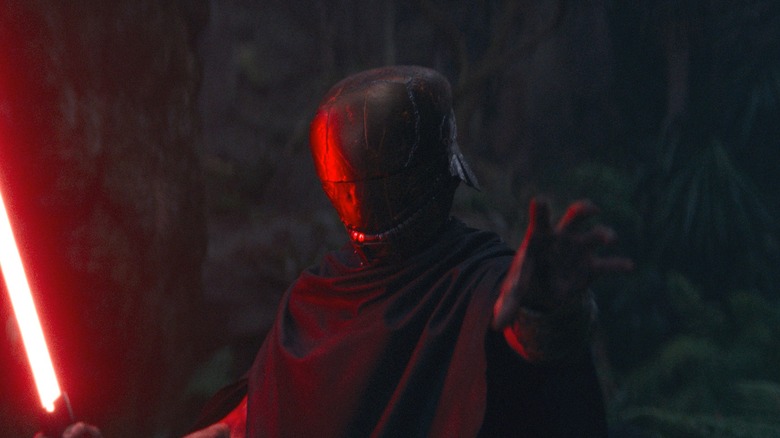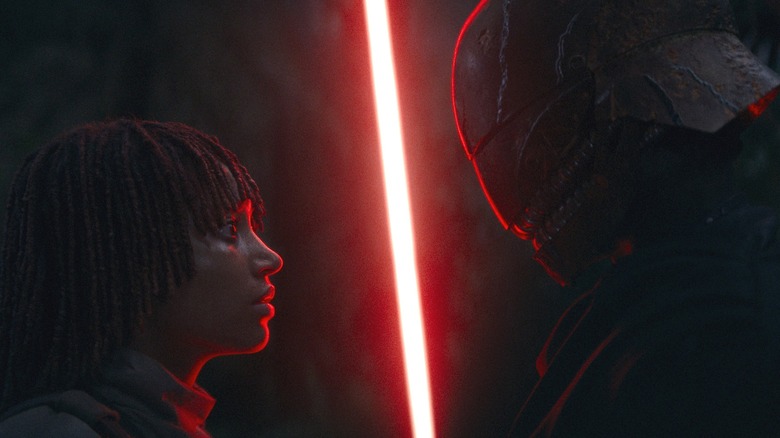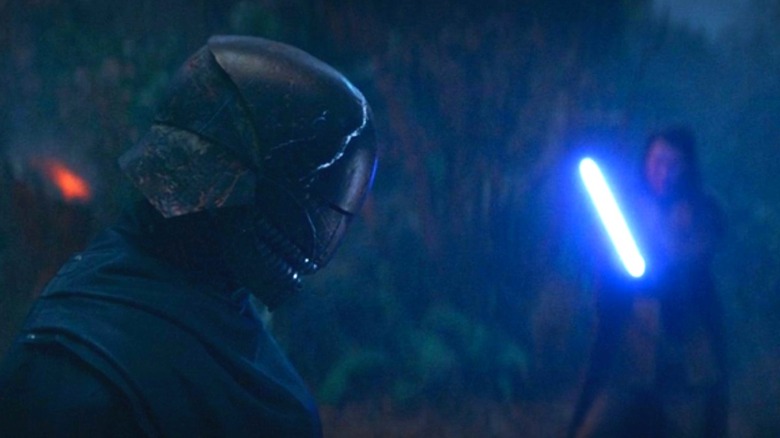How The Acolyte's Sith Villain Cut Off Lightsabers & The Force In Episode 5
This article contains spoilers for "Star Wars: The Acolyte" Episode 5 — "Night"
Star Wars fans are already heralding "The Acolyte" Episode 5 as one of the best lightsaber fights of the Disney era, both for how it evokes the prequel trilogy and for how it innovates on that formula. When the mysterious dark side user who's been training Mae (Amandla Stenberg) pops up to ambush the Jedi on Khofar, he uses every tool in the Sith toolkit (Though he's not a Sith? Or is he?) short of Force lightning. Saber throws, Force pushes and pulls, and a bunch of fancy sword tricks are on the table, in addition to a new technique that interrupts the Jedi's lightsabers.
"Night" is basically a half-hour fight scene. Over the course of it, Mae's master, who's revealed to be the true identity of her former ally Qimir (Manny Jacinto), lays waste to the Jedi strike team led by Master Sol (Lee Jung-jae). There are eight Jedi at the start of the battle, and seven of them fall to Qimir's red lightsaber, including core characters Jecki (Dafne Keen) and Yord (Charlie Barnett) in a pair of graphic deaths.
Qimir embodies the dark side's raw power and barely breaks a sweat. He even employs a few moves that we haven't seen before, using his metal helmet as a blunt weapon that deflects and even shorts out the Jedi's lightsaber blows. That might seem strange, but it actually calls back to a powerful metal from the old Expanded Universe: cortosis.
Qimir's helmet must be made of cortosis
Cortosis was introduced in the Legends timeline in 1998 in Michael W. Stackpole's novel "I, Jedi." In the years after, it became a common sight in the EU, especially in video games like the Knights of the Old Republic series, where weapons that could stand against lightsabers were always needed. The exact nature of cortosis varied somewhat from one story to the next, but it was generally portrayed as an incredible conductor of energy, to the point that lightsabers making contact with it would briefly short out due to a kind of feedback loop. Unlike other rare Star Wars metals, like beskar, cortosis is quite brittle, making it far better at blocking energy weapons than more traditional attacks.
All of these qualities are shown in Qimir's helmet. Repeatedly in his fight against the Jedi, he blocks lightsaber blows with his head or just bashes the helmet directly into the blades, cutting them off for a short while before they start working again. However, when Sol and Jecki start laying into him with physical attacks, the helmet doesn't last long.
Cortosis already existed in the current Star Wars canon before "The Acolyte," having appeared in the popular Doctor Aphra comics and the modern Thrawn novels, among other stories. That only bolsters the theory that Qimir built his helmet out of the extremely rare material, but it doesn't explain why the metal would also protect him from the Jedi's Force powers.
Does Qimir's helmet block the Force?
Midway through the fight on "The Acolyte" Episode 5, Sol demands that Qimir remove his mask and reveal himself. Qimir refuses, saying, "And let you read my thoughts? No, no, no." It's a strange response, as cortosis isn't known to block Force awareness in this way. We also know that Jedi don't need to see a person's face to do a mind trick. Obi-Wan's been rolling persuasion checks on stormtroopers since 1977.
The natural assumption here is that this line is revealing something new about canon cortosis — that it somehow also distorts Jedi mind powers. Alternatively, the helmet could be twofold, with an outer layer of cortosis to protect against saber blows and a second, unseen element that's meant to defuse Jedi Force powers.
There could be some deeper piece of dark side lore being revealed here. Cool helmets have been a Sith trademark ever since Darth Vader, with everyone from Kylo Ren and Darth Momin to EU legends like Darth Revan all wearing iconic helmets. Even in canon, where Sith ghosts are hard to come by, these masks often hold the lingering spirits or dark Force essence of their former owners after death. Is Qimir's line suggesting that there's a greater utility to a dark side mask? Or is he just goading Sol and clouding his mind through more typical dark side techniques? Hopefully, "The Acolyte" will answer these questions in time.


